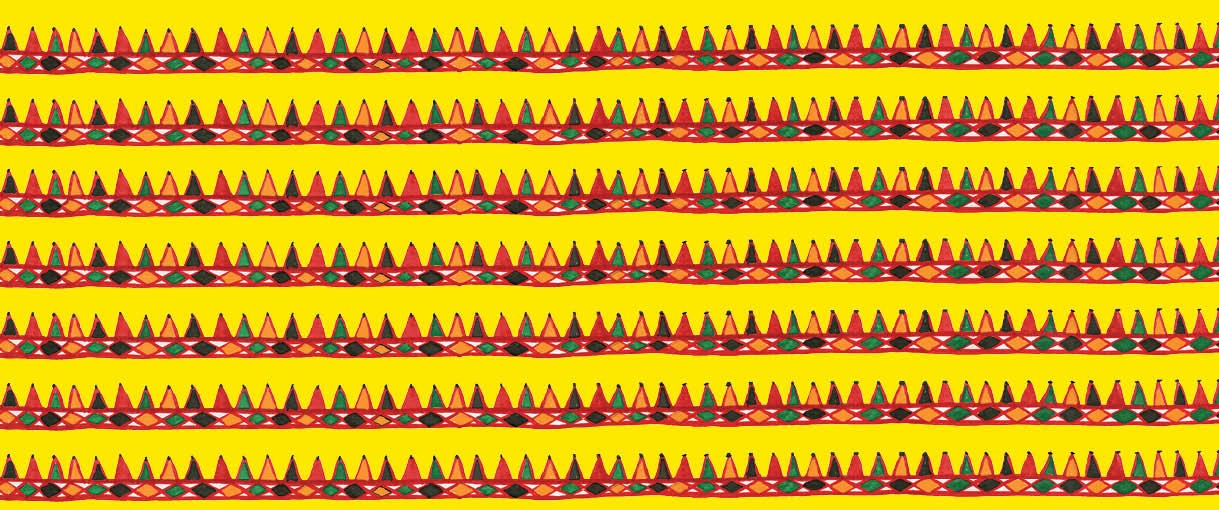
01 Jul Pithora Painting and the Coming of Better Times
by Gita Wolf
What potential does art offer as healing in the time of a pandemic? As we all emerge slowly from a year filled with illness, death, and despair, we wanted to look forward to better times by recollecting a myth that’s curiously comforting. There is a belief amongst the indigenous Rathwa tribe from Gujarat that creating a particular painting—called Pithora—banishes adversity and brings about a change in fortune.
We first heard about this restorative power of art almost a decade ago, when we met two Rathwa artists, father and son, called Bhaddu and Harsingh Hamir. They were painting a Pithora mural at the Manav Sangrahalaya Museum for indigenous art in Bhopal, where we had been invited to hold a workshop with a large group of folk and tribal artists. But that’s another story…
To get back to this one: we were so taken with Bhaddu and Harsingh’s art that we invited them to come to Chennai in 2013 and work with us on book projects. For some reason, they didn’t arrive when they said they would… After nearly a week of frantic searching, we located them 2000 miles away, in Delhi, and discovered that they’d taken the wrong train. Inherently laid back by nature, they seemed quite unfazed by this. Once we finally got them to Chennai, the first thing Bhaddu and Harsingh said was that it was time to paint a Pithora mural. Things would be set right. The beautiful painting they created for us is still on the wall at Book Building, our space in Chennai.
Harsingh Hamir decorating the Pithora mural at Book Building
To Paint is to Honour
A Pithora painting depicts the god Pithora and the goddess Pithori, who appear in the form of horses. They are always in the centre, flanked by the horses of Rathwa ancestors. Various other gods and goddesses of destiny are present too, along with the sun and moon. Apart from these figures, other elements in any particular painting can vary, depending on how large the piece is and what the artist wants to bring in. It usually includes different Rathwa myths and chronicles, with kings, farmers, cowherds, traders, musicians, hunters, shamans and ordinary village folk as part of the picture. Domestic and wild animals are present as well, along with cultivated and wild plants. However large or small, a Pithora painting tries to show and honour everything that exists in the world.
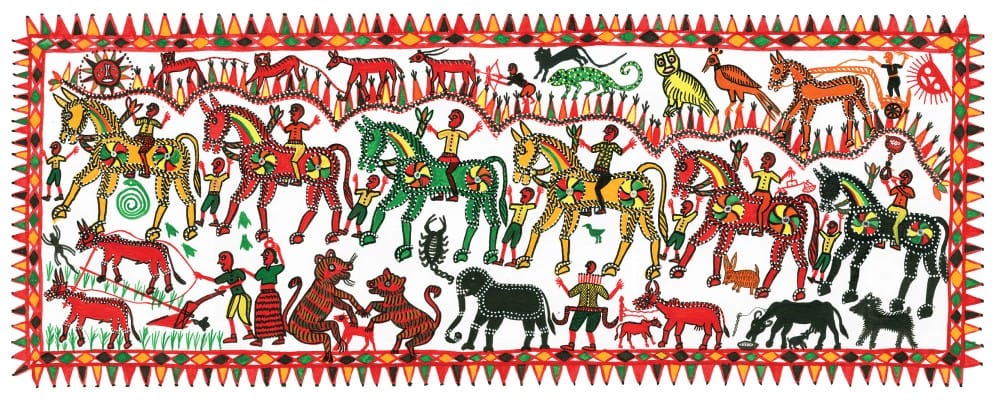
A Pithora Mural
The story goes that when the community forgets to honour the gods of creation, ill luck and disease strikes everyone. To restore peace and prosperity, as a kind of votive offering, artists are commissioned to create a Pithora wall painting. Traditionally, this painting is renewed and painted afresh each year to ward off against potential misfortune.
Bhaddu and Harsingh were quite clear that what they had made for us was not a traditional Pithora mural in the true sense of the word. Ours was a secular commission that artists like them are always happy to take on, for additional income—and undoubtedly, it would bring good luck and happiness both to the creator and to the viewer. But it was not a fully consecrated painting, which usually involves an elaborate communal ceremony. After a ritual mural is complete, the entire village assembles in front of it and a badva, a wise man or shaman, then ‘reads’ and interprets the picture to the audience. This can take hours, since each of the elements in the painting contains stories and meanings that need to be teased out. Interestingly, the Rathwa term for an artist is lakhara, which translates to scribe, or carrier of stories. Once the stories in the painting are told, and the ceremony is done, a large and happy communal feast follows, accompanied by music and dancing.
It’s rare for outsiders to get to see this, so we were delighted when Harsingh recently sent us some images and footage of the going-ons around a Pithora painting ceremony.
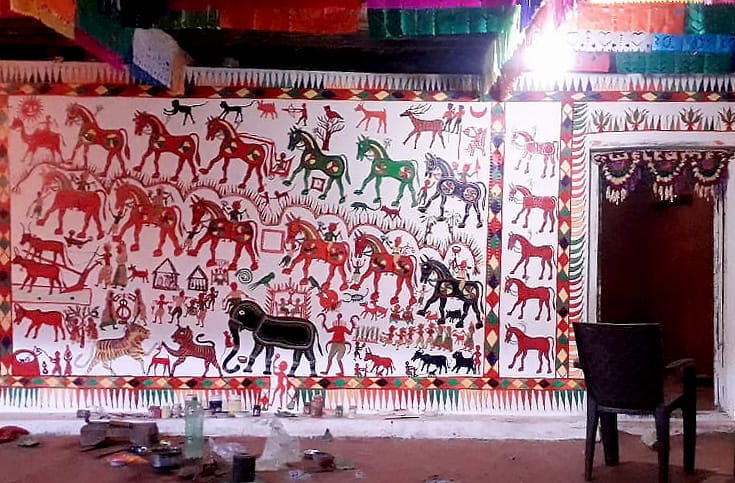
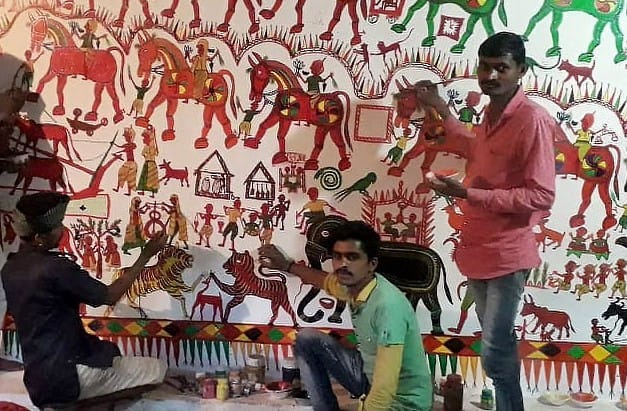
Freshly painted ceremonial Pithora mural and festive celebrations at Hansda Village, Gujarat
Moving Tradition Forward
When Harsingh sent us this material, we could see how proud he was of his heritage. During the 15 years that we’ve worked with indigenous artists, we’ve come across this deep cultural pride repeatedly, it’s something artists seek to share and keep alive. At the same time, they’re not stuck in their inherited past—on the contrary, they’re quite open to the new, in a flexible and select fashion. The very fact that Harsingh had used his mobile phone to film and send us this material was a testament to this.
Traditional artists work within their tradition, but the adventurous among them are eager to find new ways of taking their work forward. Bhaddu and Harsingh see their role in Rathwa community culture as quite separate from other work they take on, to make a living. They, like other Rathwa artists, now paint not only on walls, but on canvas, paper and other material. They regularly exhibit and sell their work in museums, galleries and craft bazaars. Bhaddu told us that before this became customary, they would work as day labourers between mural commissions.
There is something else as well: for a number of artists, the thirst for new inputs is not just about earning money in the short term. Bhaddu and Harsingh were also happy to come and work with us because they had heard from other artists that we made books – and while they themselves were not formally literate, they had an enormous respect for books, which was poignant, and humbling. On the practical side, we had to explain to them the concept of royalties, as well as that of copyrights and permissions. They had been used to selling their work outright, so all this was very new.
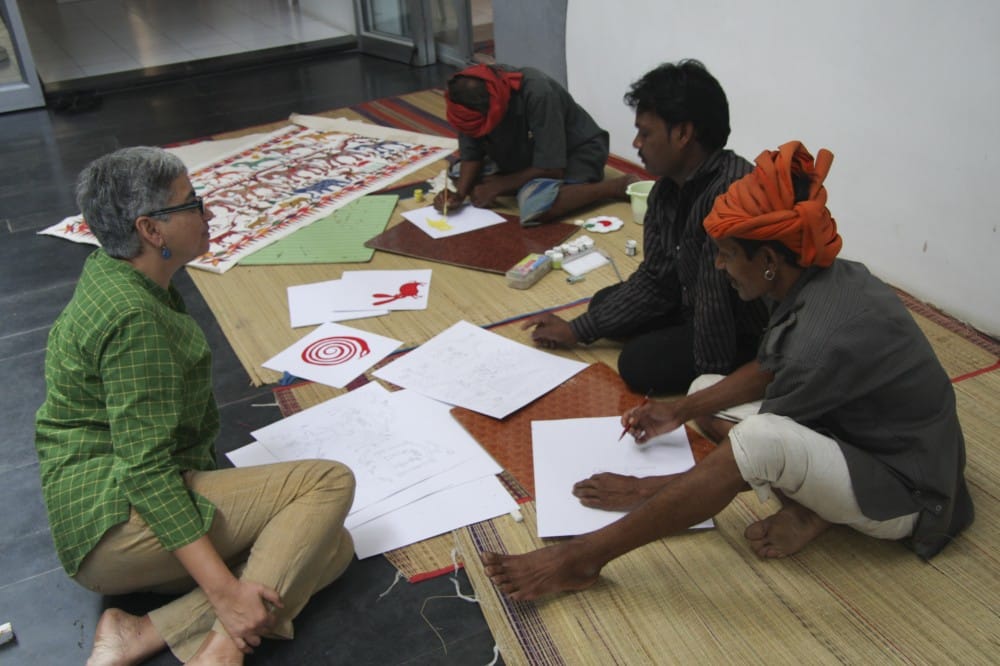
Bhaddu Hamir, Harsingh Hamir and Bhil artist Subhash Vyam with publisher Gita Wolf at Book Building
Bringing Pithora Art to the Book
Working with us also meant exploring novel ideas and approaches, and artists have their own pace when it comes to this. While Harsingh was ready to take on anything with youthful fearlessness, Bhaddu was more comfortable beginning with what he knew. So it was decided that Bhaddu would start on the Pithora mural, while Harsingh took on a book project.
He was excited by the idea we had, of a children’s book based on the story of how Pithora painting came to be. He and Bhaddu told us the basic story, and we wrote a text based on it. Coming up with the illustrations was a challenge for Harsingh, but he enjoyed it. He was a wonderfully skilled artist, but this was a new form of visual storytelling, where he had to split the story up into sequential scenes. What he was used to was an entire narrative painted in one frame, in a traditional Pithora painting. He grasped what we wanted very quickly. But even so, we decided to bring in a third voice—that of the designer—at a later stage, to break up the images even further if necessary. Harsingh was keen to see how this would turn out, and in the event, was very taken with the result.
Harsingh Hamir’s book Painting Everything in the World was published in 2018. The design emphasizes the very contemporary feel of the art, and the text follows the visuals on the page, building up the story. The finale is a surprise fold-out, which reveals a grand Pithora painting.
Much to everyone’s delight, Harsingh went on to win an international prize: the prestigious Korean Nami Concours 2019 Purple Island award for Painting Everything in the World, the first Indian indigenous artist to have done so. It was followed by an exhibition of his original art work in Seoul.
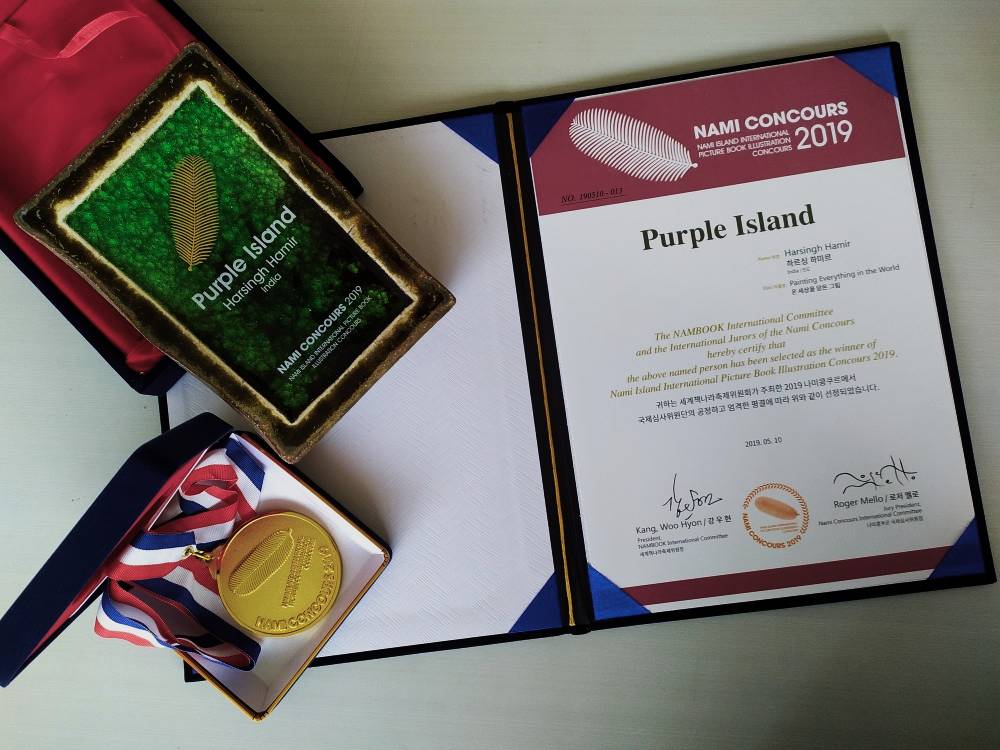
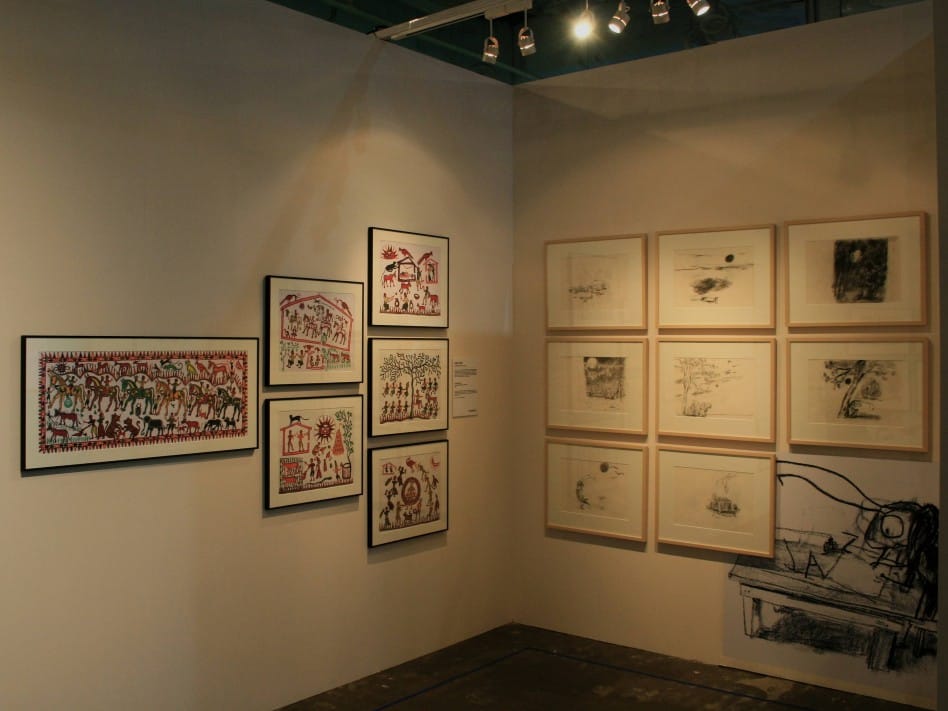
Painting Everything in the World won the Nami Concours Purple Island Award and was exhibited in Seoul
Meanwhile, what of Bhaddu? To go back to their visit to Tara, Bhaddu completed his Pithora mural for us in record time. Then, as he sat around doodling, and watching what Harsingh was up to, we had a sudden idea. We looked again at the figures in his mural: they were unique—bold, iconic and full of character. The animals in particular were funny and charming. What could we do with these shapes? Could they be part of another story? At any rate, we asked him to paint a selection of these creatures for us, very simply, in a single colour. He was bemused, but up for it. And before we knew it, we had a lovely collection of animal silhouettes, and Bhaddu was happily occupied for the rest of his stay.
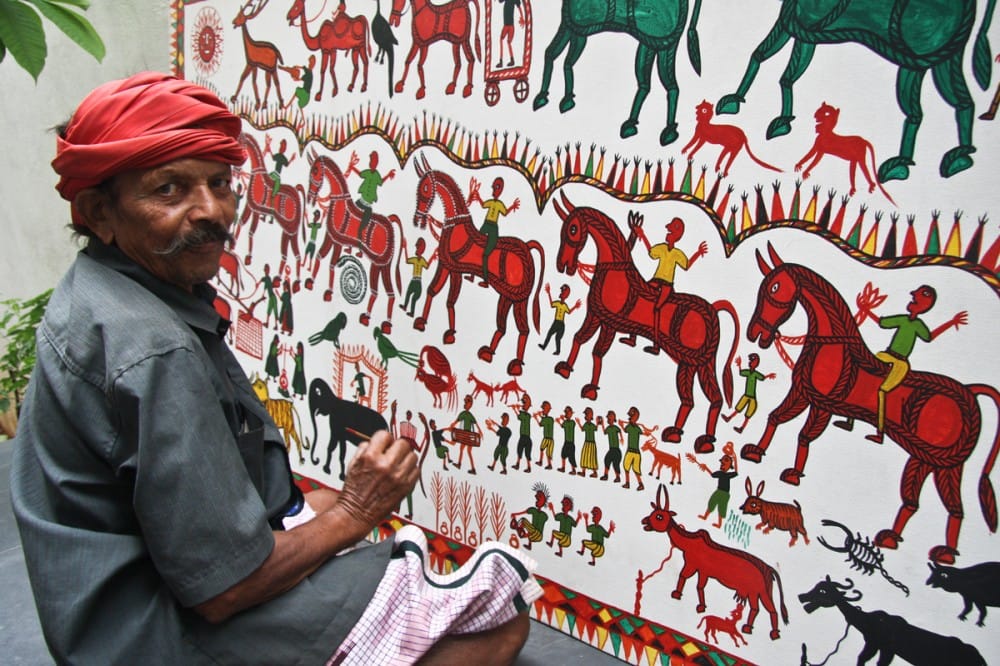
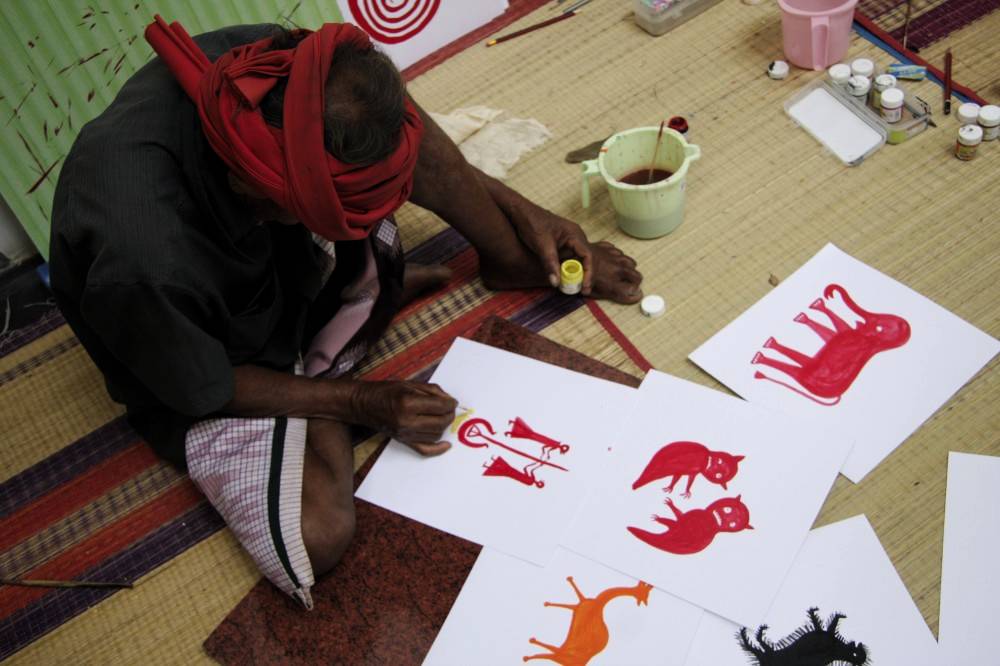
Bhaddu Hamir completing his mural at Book Building and painting animal silhouettes for Twins
After he left, we mulled over the possibilities that the animal shapes suggested—from colouring in to cut-outs—but nothing really seemed to work out. Finally, their day came in 2017, when Dhwani Shah, our resident designer at the time, turned Bhaddu’s work into a very special interactive story-telling book, called Twins. It involves animal cut-outs set in illustrated scenes, which invite the reader to trace, flip and draw/write their own stories. When we sent him the book, Bhaddu was pleased though admittedly nonplussed at the turn his animals had taken… he said he’d forgotten all about those scribbles. Happily, they continue to earn him a tidy sum in royalties each year, as the book continues to sell and get re-printed.
Pithora Elephant – Art Print
After these two projects, we haven’t had a chance to meet and work with Harsingh and Bhaddu. We stay in touch regularly, particularly with Harsingh, who is very comfortable with picking up the phone and calling us. Then, when the pandemic struck, it was a struggle for an independent publishing house like us to stay afloat, but for the indigenous artists we worked with, it was truly a massive blow. They continued to paint, but their avenues for direct sales were cut off. The royalties we paid them were only a part of their income, so we put out a call to our readers to support some of them directly, by buying or commissioning work.
Harsingh was one of these artists. In the meantime, we had created a beautiful print of an elephant that he had painted, but due to the lockdown, we weren’t able to get them signed by him. The great news is that this has now finally happened—here it is, in all its endearing majesty.
The Pithora Elephant art print is now up for sale on our website, and here’s hoping it will bring brightness and cheer to many homes… in a sign of better times to come.
Gita Wolf started Tara Books, as an independent publishing house based in India. An original and creative voice in contemporary Indian publishing, Gita Wolf is known for her interest in exploring and experimenting with the form of the book and has written and over twenty books for children and adults. Several have won major international awards and been translated into multiple languages. Click here to discover Tara Books she has authored.



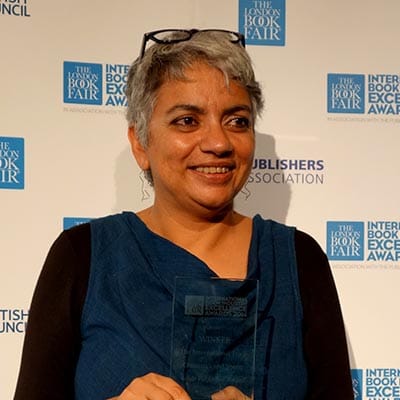
AnnieB
Posted at 07:53h, 28 SeptemberThank you. I have the book Waterlife. After looking at it recently I checked in at your website wondering how you and all your artists are doing in this difficult time.